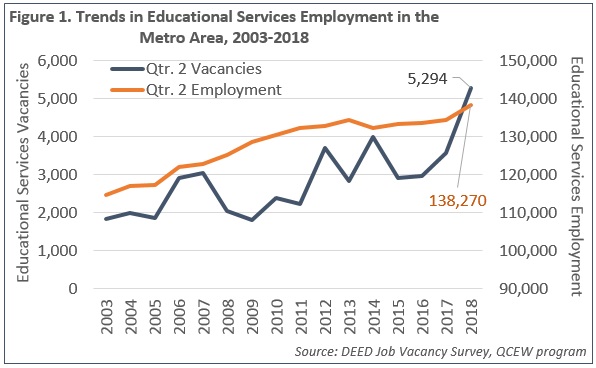 The Minneapolis-St. Paul metropolitan area is a national leader in finance, advanced manufacturing, agriculture and retailing.
The Minneapolis-St. Paul metropolitan area is a national leader in finance, advanced manufacturing, agriculture and retailing.
Medical devices, electronics and processed foods are strong suits recognized globally.
Want the freshest data delivered by email? Subscribe to our regional newsletters.
3/13/2019 11:30:00 AM
Tim O'Neill
Governor Tim Walz recently released his Budget for One Minnesota, with one of three focus areas being Education. Whether or not you agree with the specifics of the budget proposal, one thing should be clear: educational services are vital to Minnesota’s economy and its people.
Recent employment and vacancy statistics highlight significant trends within Educational Services in the Twin Cities Metro Area. Way back in the second quarter of 2003, the Metro Area had 2,044 Educational Services establishments supplying 114,562 jobs. Fifteen years later, during the second quarter of 2018, this industry had 2,165 establishments supplying 138,270 jobs. So where the number of establishments increased by just 5.9 percent over the past 15 years, employment increased by 20.7 percent, or more than 23,700 jobs (Figure 1). For reference, total employment across all industries in the region expanded by 11.9 percent during this span of time.

Educational Services is made up of seven in-depth sectors:
Over the past 15 years, Colleges, Universities, and Professional Schools gained 9,365 jobs in the Metro Area, making it the largest-growing sector within Educational Services during that time. Elementary and Secondary Schools wasn’t far off this mark, gaining 7,796 jobs. Together, these two sectors account for over 85 percent of the region’s total employment in Educational Services. So it makes sense that they’ve witnessed the most growth over the last decade and a half.
Other sectors, however, are growing much more rapidly. Gaining 3,687 jobs, Educational Support Services witnessed an incredible 501.0 percent growth between 2003 and 2018. This put it as the region’s second fastest-growing sector out of nearly 250 sectors (NAICS 4-digit) during that time. Growing by 75.4 percent, equivalent to 3,847 jobs, Technical and Trade Schools also witnessed rapid growth between 2003 and 2018.
Along with employment growth in Educational Services, the number of open job vacancies has also risen rapidly over the past 15 years. Such vacancies spiked by 48.3 percent between the second quarters of 2017 and 2018 alone (Figure 1). For reference, total vacancies in the region climbed by 11.1 percent over-the-year. Those Educational Services occupations with the most vacancies (2nd Quarter, 2018) include:
Contact Tim O’Neill at 651-259-7401.